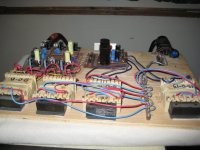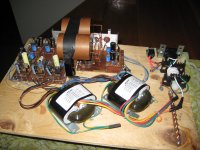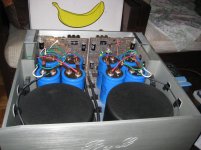Sort of...
You need to look at the devices 'absolute maximum ratings' which are always given in the data sheet and from there apply and de-rating that may be specified such as power dissipation vs temperature.
Max current is always specified and many opamps are short circuit proof anyway but you still need to make sure dissipation stays within limits with regard to temperature.
There is no minimum loading because ultimately it depends on how much voltage you are trying to develop across a load. A 10 ohm load is fine if you are working with millivolt signal levels.
You need to look at the devices 'absolute maximum ratings' which are always given in the data sheet and from there apply and de-rating that may be specified such as power dissipation vs temperature.
Max current is always specified and many opamps are short circuit proof anyway but you still need to make sure dissipation stays within limits with regard to temperature.
There is no minimum loading because ultimately it depends on how much voltage you are trying to develop across a load. A 10 ohm load is fine if you are working with millivolt signal levels.
I have NE5534 (similar to NE5532) in my chinese dac which came with Texas Instruments ones and sounded boring and dull. I swapped for Signetics and sound improved quite a bit - bass most of all. Then I swapped for Philips opamps and I couldn't believe the difference. The music got soul and I finally was looking forward to listening. Compared to TI it was a big difference, and it is all the same op-amp, just different manufacturers.
That does cover it.

Well stated. Carry on fine job.Sort of...
You need to look at the devices 'absolute maximum ratings' which are always given in the data sheet and from there apply and de-rating that may be specified such as power dissipation vs temperature.
Max current is always specified and many opamps are short circuit proof anyway but you still need to make sure dissipation stays within limits with regard to temperature.
There is no minimum loading because ultimately it depends on how much voltage you are trying to develop across a load. A 10 ohm load is fine if you are working with millivolt signal levels.
Yes,I have used all possible ways including using Parametric eq which helps to some level.Other brands do produce fuller sound though not as perfect as DAC.
Yamaha has certainly good sound,but why cant it produce little weight at least?
I checked manual again and found the other side of PCB has whole through caps(not SMD).
An externally hosted image should be here but it was not working when we last tested it.
post DAC section-
An externally hosted image should be here but it was not working when we last tested it.
hehe, they polarized the caps behind 5532 wrong!
Hi Mats, Well, if you are going to use one of these super op amps and look at things closely, you're going to have to do more than use a chip regulator of any kind. You need to kill the higher frequency noise. That is where simple chip type regulators are weak ...
-Chris
Hi and sorry to jump in but i am very interested in this topic of high Hz noise coming from the power supply.
From what i have read here it seems that opamps are particularly sensitive to this kind of noise. Have i misunderstood ?
I wonder if replacing for instance a toroidal power transformer with a separated bobbins type (C-type or EI type) could kill some of this high Hz noise coming from the mains.
Another question. Can the regulator chips themselves generate some kind of Hz noise ? i am referring to to the common and cheap LM78XX fixed regulator series.
Thanks a lot for the always great advice.
Kind regards, gino
Last edited:
Do not worry about it. Almost every power supply is suitable for OP amps. You can take 78xx or LM317. I prefer the 317, because it is even less noisy than the 78xx. The OP itself has then again -80dB and more noise reduction. Use toroidal transformers only. Electromagnetic fields should not be underestimated. The noise comes not throu the power lines but from the air (transformer fields).
Last edited:
Do not worry about it. Almost every power supply is suitable for OP amps. You can take 78xx or LM317.
I prefer the 317, because it is even less noisy than the 78xx.
The OP itself has then again -80dB and more noise reduction. Use toroidal transformers only. Electromagnetic fields should not be underestimated.
The noise comes not throu the power lines but from the air (transformer fields).
Hi and thanks a lot for the valuable advice and explanation.
Actually in low voltage equipment (i.e. dacs, preamps, ecc.) i see that toroidals are much more common.
Nevertheless I also remember an old interview of Mr. Curl where he was sustaining that split bobbin transformers have some advantages when the task is to suppress high Hz noise coming from the grid.
Something like the one in the picture i guess.

or another type
Last edited:
Note that there are significant differences between LM317s from different manufacturers. ONs are better than TIs, but the best are the LT317s from Linear Technology---≥16db better ripple rejection, and -10db less noise. They ARE more expensive, but for good reason.Do not worry about it. Almost every power supply is suitable for OP amps. You can take 78xx or LM317. I prefer the 317, because it is even less noisy than the 78xx. The OP itself has then again -80dB and more noise reduction. Use toroidal transformers only. Electromagnetic fields should not be underestimated. The noise comes not throu the power lines but from the air (transformer fields).
I remember reading one poster who said that Neve (recording console manufacturer) actually paid him to replace the 800 (!!!) Raytheon NE5534s in a Neve console because they were not meeting datasheet specification. I believe he used Nationals. So there certainly CAN be a difference in performance between manufacturers.I have NE5534 (similar to NE5532) in my chinese dac which came with Texas Instruments ones and sounded boring and dull. I swapped for Signetics and sound improved quite a bit - bass most of all. Then I swapped for Philips opamps and I couldn't believe the difference. The music got soul and I finally was looking forward to listening. Compared to TI it was a big difference, and it is all the same op-amp, just different manufacturers.
I have NE5534 (similar to NE5532) in my chinese dac which came with Texas Instruments ones and sounded boring and dull. I swapped for Signetics and sound improved quite a bit - bass most of all. Then I swapped for Philips opamps and I couldn't believe the difference.
For at least as long as I've been designing professionally, Signetics has been Philips. Wikipedia says Philips bought them in 1975.
... It is the way to go !
l Torroidal only for big job
Hi and thanks a lot for the very interesting advice.
I guess you have come to this conclusion after some testing with transformers of different type ?
I have noticed that lab grade power supplies usually adopt EI transformers.
Toroidals are more "transparent" to grid noise. They tend to let it through passing the task of suppressing it to following stages.
Maybe this can be seen also on a scope ?
Maybe AC line filters can give similar results i do not know.
Last edited:
Quite some outdated info in this thread. Best transformers for audio light use (let's call DACs and preamps "light" use) are Rcore transformers very closely followed (if not exceeded) by split bobbin types and the least preferable are toroids. Toroids however are relatively cheap, most easy to mount, have a low stray field and they are most easy to find. This explains their popularity. For power amps I am not the one to comment. If Rcore transformers would be as easily available as toroids I think not many would use toroids. I use them too as they are cheap and not every project needs the best transformer available. However, I have experienced quite some times that toroids hum because of a slight DC component on the mains voltage. Something you will not likely experience with split bobbin or Rcore types.
LM317 is old news. There has been a revolution called LT3045. LM317 does not even come close. For now a negative PSU can be made with + connected to GND or LT3090 can be used but it is not as excellent as the LT3045. I just hope a negative version will be produced.
LM317 is old news. There has been a revolution called LT3045. LM317 does not even come close. For now a negative PSU can be made with + connected to GND or LT3090 can be used but it is not as excellent as the LT3045. I just hope a negative version will be produced.
Last edited:
LM317 is old news. There has been a revolution called LT3045. LM317 does not even come close.
As I said: the voltage reg doesn't matter. LT is a waste of money. U won't hear it!
Did you try ? I did. Only old farts keep using LM317/337 because it is the best of the old stuff. BTW I am in the same club but keep an eye open for better stuff  No design in the world performs less good when using better regs. Please beware of making statements based on assumptions, audio is not a religion.
No design in the world performs less good when using better regs. Please beware of making statements based on assumptions, audio is not a religion.
Also if one wants to design greener it is advisable to use LDO regs. Less drop = less heat. LT3045 are SMD so less board space means smaller boards. Too much positive features to justify keep using LM317 IMO.
Also if one wants to design greener it is advisable to use LDO regs. Less drop = less heat. LT3045 are SMD so less board space means smaller boards. Too much positive features to justify keep using LM317 IMO.
Last edited:
- Home
- Source & Line
- Analog Line Level
- Drop in replacement for NE5532?


